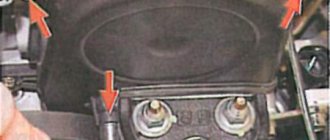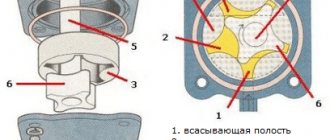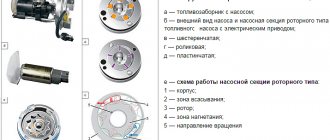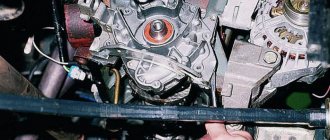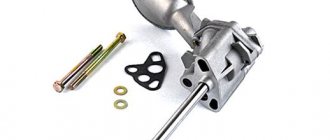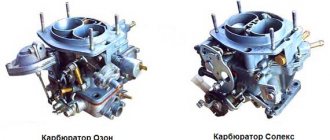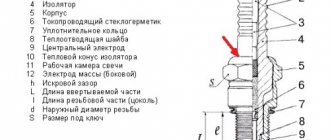Engine lubrication for VAZ 2107
The main positions of the system for lubricating the engine of a VAZ 2107 car are shown in the photo:
- 1 – oil pump;
- 2 – pallet;
- 7 – front crankshaft oil seal;
- 9 – gear and bushing of the ignition distributor and pump drive;
- 10 – shaft of the ignition distributor and oil pump drive;
- 11 – oil drain;
- 16 — filler neck for oil filling;
- 17 – inclined channel in the cylinder head;
- 18 – vertical channel, cylinder block;
- 19 – main highway;
- 20 – oil pressure control sensors;
- 23 – oil level indicator;
- 24 – filter;
- 25 – bypass filter valve;
- 26 – anti-drainage valve.
Oil supply channels:
- 3 - to the filter from the pump,
- 4 – into the oil line from the filter;
- 5 – to the ignition distributor and pump drive gear;
- 6 – in the crankshaft journal;
- 8 – to the ignition distributor, drive shaft, to the main bearing – from the oil line;
- 21 – to the main bearing;
- 22 – to the connecting rod bearing from the main bearing;
To reduce the friction forces between engine parts, the device uses lubricant. The formed film replaces friction between the surfaces of mating parts with friction of lubricant layers between them. Using oil protects:
- Engine overheating.
- Parts from the formation of corrosion on their surface.
- Oil removes solid particles from the interface between rubbing parts, which increases the durability of the unit.
- Seals emerging gaps.
The complex of additives used in engine oil provides high lubricating properties, increases resistance to oxidation, and increases the ability of the product to operate over a wide temperature range. The VAZ 2107 has a combined lubrication system for engine components and parts. Lubricated under pressure:
- Bearings - main and connecting rod.
- Camshaft supports and cams.
- Ignition distributor roller bearings.
- Ignition distributor and pump drive gear.
Flowing from the gaps and splashing during the movement of parts in the engine are lubricated:
- Piston pins.
- Pistons with rings.
- Camshaft drive chain.
- Cylinder walls.
- Valve stems located in guide bushings.
- Valve lever supports.
Replacing the oil pump
There is nothing difficult about replacing an oil pump. We drive the car into the pit, prepare the tools and get to work.
Removing the battery terminal for repair
The plug is unscrewed with a key
Timing belt without casing.
The location of the 6 bolts that secure the oil pump is marked with arrows
Reassemble the oil pump in reverse order.
The pan and oil pump gaskets must be replaced with new ones. Also, the new oil pump should be washed out of preservative grease and filled with oil (to prevent it from running dry during the first start after repair).
Why is an oil pump needed?
Pump appearance
The oil pump in the engine is designed to build up pressure in the oil system, for the necessary lubricating effect of all rubbing parts of the internal combustion engine. If the pressure in the system is insufficient, the lubrication effect will be ineffective, which in turn will lead to the engine being unsuitable for operation. In this case, the low oil pressure warning light on the instrument panel should light up. Therefore, you should not delay repairing the oil pump.
You are left with two options. Take the car to a service station and lose a lot of time and money, or change the oil pump yourself.
Pump diagnostics
Oil pump removed for diagnostics. Symptoms: oil leak.
Secondly, you need to check whether power is supplied to it correctly or whether a wire is broken somewhere. And only after these procedures, if the light does not go out, will you have to change the oil pump.
Why might it break prematurely?
An oil leak from the oil pump can lead to expensive engine repairs.
Replacement of the oil pump can also be caused by poor quality oil, which will lead to rapid clogging of the oil receiver grid and subsequent lack of oil pressure in the system. It is not uncommon for an oil pump to become wet and oil to leak from underneath it. In these cases, you can get by by replacing the gasket and cleaning the oil receiver mesh.
Engine lubrication
To ensure the required oil pressure in the line and compensate for its consumption during engine wear, the oil pump has increased performance.
- The gear driven oil pump is mounted inside the oil pan. The pump is attached to the cylinder block using two bolts of different lengths. The drive gear of the product is fixedly fixed on the roller, on an axis fixedly installed in the pump body, the gear wheel rotates freely.
- Having passed through the filter mesh along the oil intake pipe, in the housing of which a pressure reducing valve is built-in, the oil is directed to the pump. The pressure reducing valve allows excess oil to pass into the oil receiver and prevents its pressure from increasing above the permissible level. An elastic spring ensures that the valve operates when the pressure increases.
- When the oil pressure drops below the permissible level, a warning light on the dashboard lights up.
- To clean the oil entering the engine, a non-separable, full-flow oil filter is installed, which must be replaced when changing the oil to ensure effective filtration.
When using a car, parts of any device gradually wear out. If it is noticed that the pump has begun to perform its functions incorrectly, the pressure differs from the nominal one: either increased or decreased at idle speed, it is necessary to replace the oil pump on the VAZ 2107.
Removing the oil pump
To work you will need:
- Socket wrenches for “13” and “10”.
- Extension.
- Cardan joints.
Advice: It is better when replacing the oil pump on a VAZ 2107 is done on an inspection pit or a lift.
Dismantling procedure:
- Replacing the oil pump on a VAZ 2107 begins with disconnecting the wire from the battery.
- Oil is drained from the engine crankcase.
Tip: To improve oil drainage, the engine must be warmed up well to operating temperature.
- The engine splash guard is removed.
- The nuts securing the engine front suspension cushions to the cross member are unscrewed. In order for the pillow pins to easily come out of the holes, the engine must be slightly raised using a jack or hoist.
- The engine crankcase of a VAZ 2107 is removed.
- The oil pump is removed.
Replacing the VAZ 2107 oil pump is carried out in the reverse order of its removal.
Tip: you need to pay attention that the bolts for fixing the VAZ 2107 oil pump are of different lengths. When installing them, you need to make sure that they fall into place. The cost of repairs can be reduced if you do not completely change the oil pump, but replace or repair only worn parts, and then assemble the device yourself.
The cost of repairs can be reduced if you do not completely change the oil pump, but replace or repair only worn parts, and then assemble the device yourself.
How to properly disassemble the VAZ 2107 oil pump
It is better to disassemble the product by first placing it in a vice:
- By unscrewing the bolts, the inlet pipe with the pressure reducing valve is disconnected.
- The cover on the oil pump housing is removed.
- The axle with the drive gear and the driven gear are removed from the device body.
Automatic transmission oil pump | Repair | Signs of malfunction | Location
During operation, the oil pump in the gearbox is subjected to the most severe loads, and therefore quite often fails. Problems with the oil pump can be expressed either in the complete inoperability of this element or in a drop in pressure in the lubrication system. Modern automatic transmissions, which use numerous sensors, have the ability to monitor pressure in the system, which allows the car owner to be warned if there are problems with the pump. In most cases, eliminating this breakdown involves replacing the failed element.
Content :
Pressure reducing valve
The design of the gears is very simple, which is why they rarely break. As a rule, the gap between the teeth simply increases and the oil is pumped worse. But much more often, the bypass valve breaks, which is necessary to control the pressure in the system. If necessary, this element increases or decreases pressure. And this is done very simply - the valve opens at high pressure and closes at low pressure.
Bypass valve design:
- The case is small in size.
- Valve (small ball that closes the oil passage).
- Spring.
- Bolt for stop.
The element is placed inside the housing of the VAZ-2106 oil pump. The price of the valve is no more than 200 rubles. And if the cause of the breakdown lies precisely in it, then it is easier to change only the valve. After all, the cost of the entire pump is about 1,500 rubles.
Automatic transmission oil pump - causes of malfunction
Poor quality oil
The main reason for pump failure in a gearbox is the use of low-quality oil. During operation, wear particles and coking oil settle on the moving elements of the pump itself. All this leads to problems in the operation of the pump, which ultimately contributes to its failure.
Use only original automatic transmission oil
Improper use of the vehicle
We also note that the cause of breakdowns may be improper operation of the car in the winter season. Quite often, car owners do not warm up the transmission oil, but start driving in a cold car. As a result, the oil does not have the proper viscosity, which leads to excessive load on the automatic transmission oil pump . Under the influence of such a load, it quickly fails.
Automatic transmission oil pump repair
Signs that suggest repairs
Problems with the oil pump in the transmission lead to insufficient lubrication of the moving parts and an increase in the overall temperature inside the transmission. As a result, significant problems with moving mechanical parts can occur, resulting in the need for costly and complex repairs. That is why at the first sign of oil pump failure, we recommend that you contact experienced specialists. The car owner can identify problems with the gearbox by the appearance of noticeable jerks in the automatic transmission when shifting some gears, which may indicate insufficient lubrication of the clutches, acceleration dynamics suffer, and a continuous howl appears, which changes depending on engine speed. We recommend that you contact the service center as soon as possible, which will allow you to fix the breakdown at minimal cost. Repair of the automatic transmission pump should be carried out by experienced specialists.
To replace the automatic transmission pump, you must first remove the box
Location
The oil pump in an automatic transmission is located inside the gearbox, so if problems arise with this element, it is necessary to dismantle the protective metal casing from the automatic transmission. In most cases, repair work does not require removing the transmission from the vehicle. However, in this case, you must take into account the design features of each specific vehicle and specific modifications of the automatic transmission. Only an experienced technician will be able to quickly determine the location of the oil pump and carry out all the necessary repair work as quickly as possible.
In order to understand the location of the oil pump, familiarize yourself with the automatic transmission structure as a whole.
The design and principle of operation of the oil pump - Video
Replacing the automatic transmission oil pump - as a way to fix the problem
As mentioned above, repair work with the oil pump consists in most cases of replacing this element. It is not very expensive, so car owners and service workshop specialists do not recommend restoring a damaged unit and replacing it with a new pump. In this case, we recommend using only original spare parts, which will guarantee the durability and trouble-free operation of this unit.
Let us recall the common reasons that contribute to automatic transmission pump breakdowns. First of all, such reasons include insufficient oil level in the system. That is why the car owner needs to closely monitor the oil level in the gearbox. It is recommended to carry out this procedure every month on a special overpass or inspection pit.
Wear of the oil pump automatic transmission ZF 4HP20
If the gearbox is repaired incorrectly, problems may occur with the flexible disk, which is necessary for attaching the automatic transmission torque converter to the engine. If the installation technology is violated, the gearbox cannot maintain the size of the end gap, which also leads to problems with the oil pump. Quite often, a car owner operates his car in the most severe mode, which involves fast driving and sharp braking. This mode of operation leads to rapid wear of the entire gearbox and the pump in particular. Problems with the oil pump in the gearbox can occur if the vehicle is not properly maintained.
If it is necessary to repair the oil pump, you must contact experienced specialists who repair gearboxes. If you have special diagnostic equipment, the technician will be able to accurately determine the breakdown and fix it as quickly as possible. In most cases, repair work to replace the oil pump in the gearbox takes about one working day. At the same time, the oil and oil filter elements are replaced. This ensures maximum durability and trouble-free operation of the vehicle.
How to change engine oil on a VAZ 2101-VAZ 2107?
Draining: 1) First you need to remove the cap from the oil filler neck.
2) Next you will need to unscrew the drain plug.
3) Whatever pollutes the environment, place some container for drained oil.
4) After the oil has poured out of the hole, you will need to screw the plug back on.
5) Now unscrew the oil filter and remove it.
Note! You can unscrew the oil filter by hand, but if nothing comes out, use a special wrench!
Pouring:
If you are going to fill in with a different brand of oil, then you need to: 1. Drain the old oil. (We do not change the oil filter!) 2. Fill in new oil to the bottom mark on the dipstick. 3. Start the car and let it run for about 10 minutes. (You can’t move away!) 4. Turn off the car and drain the oil. 5. Replace the oil filter with a new one. 6. Now you can fill in new engine oil. (You need to fill up to the top mark on the dipstick!)
If you are not going to change the brand of oil, then you need: 1. First, pick up a new oil filter. 2. Then pour new engine oil into it, one-third of the filter volume. (A third of the volume is slightly less than half the filter.) 3. Then lubricate the filter O-ring with new engine oil. 4. Then screw the new filter into place. (Wrap it with your hands!) 5. Now you need to pour clean oil into the oil filler neck (For convenience, you can use a funnel!) 6. After pouring the oil, start the car and let it run for a few minutes. (You should not drive the car right away!) 7. While the engine is running, look to see if oil is leaking from under the drain plug or oil filter.
Important! 1. The oil must be drained at engine operating temperature! (Draining oil on a cold engine is “PRIMBERED”)
2
Also, when draining used oil, be careful because the oil is hot!
2. Also, when draining used oil, be careful, because the oil is hot!
For newbies! Question: What does the oil filter look like? Note: The oil filter may come in different colors! Answer:
Question: What does the special wrench for unscrewing the oil filter look like? Note: This is one of the types of keys that come in other shapes! Answer:
Additional video on replacement: Below is a video in which you will learn in detail the instructions for changing the oil:
Welcome! The oil in the gearbox is replaced quite rarely, but it still needs to be changed at certain intervals. Otherwise, if you do not change the oil on time, then it will gradually lose its properties and the package of additives that are added to it, as a result of which this will lead to the fact that the oil will begin to oxidize and thereby have a very detrimental effect on the box.
Note! To change the oil, you will need to stock up on: A small container of 2 liters or more, as well as a hex wrench and one 17mm wrench, if possible, also stock up on a special syringe for filling the oil and take a clean rag with you!
- Change of oil
- Additional video:
When should you change the oil in the box? In fact, the answer to this question depends on what kind of oil you poured into the system, so if the oil you poured is very bad (Fake), then it will begin to oxidize within a couple of months and thus require replacement.
But if the oil is good and is not fake, then it can last a long life. Basically, you can look up the service life of a particular oil on the Internet by typing in your brand and model of oil.
But still, the approximate frequency of changing the oil in the gearbox is “40,000-60,000 thousand km” or “3 years” from the date of filling the oil. (Whichever comes first)
Note! Only transmission oil should be poured into the gearbox; for more detailed information, see the article entitled: “What kind of oil should be poured into the gearbox?”
Types of oil pumps for internal combustion engines
A wide variety of car models with internal combustion engines, their operating parameters and engine types determine differences in the design of oil pumps. According to the type of control, all modifications are divided into adjustable and unregulated.
- With adjustable oil pumps, the output can be varied to obtain optimal oil pressure in the system.
- When using unregulated oil pumps, parameter correction is carried out using pressure reducing valves.
According to the type of design, oil pumps for internal combustion engines are divided into gear and rotary. In the second case, oil is transported through the system and a certain pressure is created using rotor blades, and in gear structures similar functions are performed by gears.
Gear models of oil pumps, in turn, are divided into designs with external and internal gearing.
- External gear oil pumps have gears located next to each other.
- Internal gear models house a smaller gear inside a larger one. This makes it possible to reduce the dimensions of the structure without reducing operational parameters.
Tips for changing oil 2107
To quickly and safely drain the oil, it is best to use an inspection hole or overpass, although you can simply lift the front of the machine.
It is necessary to change the oil on a hot engine; if it is cold, then you need to start it and let it run for 15-20 minutes.
Adding oil must be done with the utmost care. Overfilling the lubricant level above the maximum value mark on the dipstick can lead to oil leakage through the gaskets and seals into the crankcase ventilation system.
And the penetration of lubricant into the combustion chamber of a VAZ 2107 with a catalytic converter will lead to breakdown of the converter.
The engine marking is applied to the dipstick. Do not use an oil indicator with a different marking.
To change the oil you will need:
- hex key “12”;
- wrench for removing the oil filter;
- container for draining oil;
- flat screwdriver;
- gloves;
- new filter;
- canister of fresh oil.
Suitable accessories:
Original Lukoil Lux semi-synthetic motor oil 5W40, article number - 19300. The cost for a five-liter canister of such oil is about 1220 rubles. The original oil filter for the Lada engine is 21050101200500, its price will be 180 rubles. Analogues: Sakura C-25011K – 150 rubles, JS Asakashi C0065 – 150 rubles.
Prices are current for the summer of 2017 for Moscow and the region.
1
To change the oil, we need a little more than 4 liters of oil and a new filter, as well as a container for draining the old oil. Before draining the oil, you need to warm up the engine well.
2
Open the hood and unscrew the oil filler cap.
3
We go down under the car, find the drain plug and unscrew it using a 12 mm hexagon.
4
We finish unscrewing by hand and press lightly, then sharply remove the cork and substitute the container. Let the oil drain.
5
We climb under the hood and find the oil filter, here it is, next to the fuel pump. To do this, you can use a special puller, but you can also do it by hand; unscrew the filter and throw it away.
6
We take out a new filter, pour a little oil into it and lubricate the rubber band with the same oil for a better fit.
7
We go down under the car and tighten the plug.
8
We install a new filter, it is better to do this with both hands.
9
We cover the oil filler neck with rags, and here we have it.
10
Fill in oil, about four liters.
11
We measure with an oil dipstick, it shows maximum, which means it’s enough.
12
Wipe the neck and valve cover dry and close.
13
We start the engine and let it run for a few minutes, you need to circulate the oil through the system. That's it, the oil change process is complete.
Purpose of the oil pump
For most engine parts, static lubrication is not enough - they require regular supply of fresh portions of lubricant, pre-cooled and filtered from wear products. Therefore, it is important to ensure oil circulation in the system by creating a certain pressure in the lines. It is this task that is assigned to the oil pump.
The oil pump creates a vacuum in the system by sucking lubricant from the oil pan through the oil receiver. While moving along this line, the oil is filtered through a sequential full-flow filter, or less often through a partial-flow element. The oil passing through the pump enters the main line, and from there it is distributed through channels and supplied to consumers in accordance with their operating conditions. Thus, the crankshaft and camshaft bearings receive oil under maximum pressure, the timing gears, valve mechanism and part of the cylinder mirror are lubricated by splashing, and the oil flows to the rods, pushers, and cams by gravity.
Design and principle of operation
The oil pump is driven by torque from the camshaft through a gear or pulley. There are also stand-alone pump drive circuits that use an electric motor, but they are not widely used.
Structurally, the pump is represented by a sealed metal casing, in which one pair or two pairs of gears are located. In a pair of gears, one of the gears is the drive one, that is, it is connected by a key to the drive shaft, and the second one rotates freely. When designing and manufacturing oil pumps, the main design requirement is the minimum clearance between the teeth of the interacting gears, as well as between the teeth of each gear and the housing. This is necessary to ensure maximum efficiency of the device.
The lubricant is transported in the depressions formed between the teeth of the interacting gears as they rotate. Thus, the gears “squeeze” oil into the main channel in a continuous flow, forming the required pressure, the regulation of which is assigned to the pressure reducing valve.
The pressure reducing valve is most often located in the oil pump housing and is necessary to protect the lubrication system from excess pressures, which are especially dangerous when starting a cold internal combustion engine, when the viscosity of the lubricant is high. The valve is located in a channel, the opposite edges of which are connected to the discharge and suction chambers of the oil pump. When the pressure is normal, the channel is blocked by a piston or ball, which is pressed by a spring. The compression of the spring is controlled by an oil plug, thereby setting the pressure in the system. When the threshold value is exceeded, the piston or ball moves away from the seat, opening the channel and releasing part of the oil pumped into the main line back into the suction chamber.
Modern oil pumps are divided into one- and two-section. The difference between the two-section system and the design described above is the presence of an additional housing section, the gears of which are responsible for supplying oil to the oil cooler for cooling, usually with subsequent drainage into the sump. A classic example of such a device is the engine pumps of trucks of the ZIL and YaMZ brands.
Fuel pump design
Depending on the type of drive, fuel supply pumps are divided into two large groups: mechanical and electrical. The former are used only in carburetor engines, and also as booster pumps in diesel engines. The latter are used for both gasoline and diesel engines.
Mechanical fuel pumps
Mechanical fuel pump design
The mechanical pump is located on the engine and driven by a special eccentric. Structurally, it consists of the following elements:
- frame;
- diaphragm;
- pusher;
- stock;
- return spring;
- valves on the suction and discharge channels;
- filter;
- eccentric.
In cars equipped with rear-wheel drive, the eccentric is located on the oil pump drive shaft, and in cars with front-wheel drive it is located on the engine camshaft. The movement of the diaphragm in such a pump ensures the movement of fuel. When the diaphragm is at its lowest point, a vacuum occurs in the working chamber, and the latter is filled with liquid. When the diaphragm moves to the upper position, fuel is pushed into the discharge pipe. The valves prevent the fuel from flowing back.
For diesel engines, such systems are often used as low pressure pumps. They perform the function of pumping fuel and are located next to the high pressure pumps (HP pumps). On the practical side, this allows you to overcome the hydraulic resistance of the filtration system and create a stable excess pressure.
Electrically Driven Fuel Pumps
Roller fuel pump. 1 – check valve; 2 – safety valve; 3 – electrical connector; 4 – electric motor; 5 – impeller
Electric pumps are installed on engines with distributed and direct injection. They are driven electrically by a battery or generator. According to their design, electric pumps are divided into the following groups:
- Vacuum. Such a pump has a similar design to a mechanical one, but the eccentric that drives the working units is replaced with an electric drive.
- Roller. In such a device, fuel moves due to the rotation of the rotor (movement of the rollers). At the moment when the distance between the roller and the rotor increases, a vacuum occurs, the suction valve opens, and the fuel is sucked in until it is completely filled. At the next moment, the rotation of the rotor ensures that the distance decreases, and fuel is supplied to the engine through the opened injection valve.
- Geared. Suction and injection of fuel is realized through the rotation of the rotor gear. It is located eccentrically with respect to the stator gear. The teeth of the gears form chambers through which the fuel passes. During rotation, the volumes of the chambers constantly change, which ensures the required pressure.
- Centrifugal. Such a pump has an impeller equipped with blades that move fuel from the suction to the discharge channel. Pressure is created due to the turbulence that occurs when the blades act on the working fluid.
- Plunger Gasoline pumps of this design are rare. Such systems are mainly used in diesel vehicles as injection pumps. They have pairs of plungers driven by a cam shaft. As the plunger moves upward, the outlet and inlet holes are closed sequentially. This forms the pressure necessary to open the injection valve and subsequently supply fuel to the engine injectors.
Design features of rotary oil pumps
As a rule, a rotary-type oil pump consists of a small number of parts, including:
- suction and discharge cavities;
- external and internal rotors;
- drive shaft.
Oil pump operation
with rotors is based on the interaction of two rotors. In unregulated designs, the oil that is drawn in is transferred into the system by rotor blades. If the pressure becomes excessive, the pressure relief valve opens and excess oil is released.
Signs of a faulty oil pump
Like any other system with moving parts, the oil pump can fail.
Malfunctions in the oil system will be indicated by an oil pressure lamp.
.
The reasons for this may be various factors, including:
- decrease in oil level in the crankcase;
- breakdown of pressure monitoring devices;
- use of low-quality oil or oil unsuitable for this pump;
- oil filter clogged;
- breakdown of the safety or lubrication valve;
- clogging of the oil pump itself and other problems.
Signs of problems with the lubrication system include:
- decrease in oil pressure;
- increase in its consumption.
This will be indicated by a warning light on the dashboard.
Emergency measures
So, the oil pressure light on the dashboard came on while driving. As already noted, you should immediately stop and turn off the engine. Since while on the road there is no way to accurately determine the cause of the problem, the only diagnostic method is a visual inspection.
After stopping the engine:
- Carefully inspect the power plant for oil leaks - valve cover, pan, oil filter, end surfaces of the engine (near the auxiliary drive pulley and on the gearbox side);
- Check the condition of the circuit to the oil sensor, while monitoring (as far as possible) the integrity of the wire;
- During the time it takes for a visual inspection, the oil will drain into the pan, so we check its level with a dipstick.
Depending on the results of the inspection and level check, we take further actions. If a slight leak is detected, and the dipstick shows the amount of lubricant below o, you can continue moving to the repair site, but first replenish the oil loss and check whether the warning lamp lights up.
To top up, you should use the same lubricant that was filled in (it is not for nothing that it is recommended to always carry oil with you for topping up) or purchase a similar one. During the movement, you should stop periodically and replenish the level.
We do the same in the case when no leaks are detected, but the level is below normal. We just add lubricant, make sure that the control light does not light up and continue on our way, periodically stopping and checking the dipstick.
If there are no leaks and the oil level is normal, it is possible that the pressure sensor is acting up. Restarting the engine after a short pause (the time it will take to inspect the engine and assess the amount of lubricant) will help verify this.
If the lamp lights up even when you restart it, it is better not to experiment, but to call for help to transport the car to the repair site.
It is strictly forbidden to operate the machine if the dipstick shows a level higher than normal or if there is a foamy whitish coating on it - emulsion (you can additionally check for the presence of emulsion on the oil filler cap).
This indicates that other technical fluids, such as antifreeze or fuel, are leaking into the pan. An excessive level of oil (liquid mixture) in the pan has a strong negative effect, as does its lack.
The problem is diagnosed by the non-characteristic color of engine oil and smoke from the exhaust pipe.
These are all the measures that can be taken in an emergency situation - when the lamp lights up while driving and there is no necessary equipment and tools for a more detailed search for the cause.
MAIN FAULTS
The design of the oil pump, no matter what type it is, is relatively simple, which ensures its reliability and long service life. And yet it does have faults, or rather there is only one – a decrease in productivity, which leads to a drop in pressure in the system. And this can lead to more serious damage, since components that are not sufficiently lubricated begin to wear out intensively due to oil starvation. This can happen for various reasons.
- The first of these does not apply to the pump, but leads to negative consequences in its operation - clogging of the oil receiver mesh with wear products and dirt. As a result, insufficient oil flows to the pump. It is not difficult to fix such a malfunction - just remove the pan and oil receiver, then thoroughly clean and rinse the mesh.
- The problem with pressure drop can occur due to wear of the pump components or prolonged operation with oil that contains a large number of contaminants. The result of this is the formation and increase of gaps between pump parts. Because of this, the lubricant simply flows through these gaps inside the injection cavity and the gears or rotors are not able to capture it in order to pump it into the line. In most cases, the performance of the lubrication system is restored by replacing worn elements or the assembly as a whole.
- The bypass valve can also create problems. Due to dirt, it can jam in the open position, and oil will constantly flow into the pan. This malfunction can be eliminated by disassembling and washing the pump and its channels.
What to do when the oil pressure light comes on on Zhiguli cars
Service center specialists advise drivers of any cars, both domestic and imported, to stop driving and turn off the engine at the first signal of a drop in engine oil. When the oil pressure sensor is triggered, it is clear that there is some problem with the engine.
First action
The first thing to do after stopping is to measure the oil level. It is likely that it is below the minimum mark and you just need to add the required amount of liquid. After adding, it is necessary to take another measurement - if the level is between the Max and Min marks, then we can conclude that the sensor was triggered precisely because of a lack of oil in the engine. Try to start the engine, if the oil can icon disappears, then the problem is solved.
In VAZ-2106, VAZ-2107, VAZ-2109 cars special oil pressure sensors were installed. Modern models have not used this type of device for a long time. The oil pressure sensor on all cars of the Zhiguli family performs the same function - it measures the amount of lubricant in the engine unit. If there is not enough oil, the friction force between the moving parts of the engine increases, and this leads to rapid breakdown of both the valves, the camshaft or crankshaft, and cylinders.
The oil pressure sensor on classic VAZ models is mounted directly on the engine itself. And in the cabin, on the left side of the steering wheel, there is a dial-type indicator that shows the driver the current state of oil pressure. However, the oil can itself lights up only in one case - when there is completely no pressure in the system. The sensor cannot show any intermediate positions: either the pressure in the system is normal or there is no pressure at all.
What's next
Therefore, if you have checked the oil level and it is normal, you will need to take other measures. Maybe you recently changed the engine oil to new one? In this case, the likely cause of a sharp drop in oil pressure while driving is a defective filter. Alas, this is not uncommon these days. You will have to carry out the procedure of changing the oil and oil filter again.
Checking the sensor
Do not exclude the possibility that the oil pressure sensor is to blame. It is likely that the engine is not in any danger at all, but the sensor wiring is shorted or its life has expired, which is why it is sending incorrect signals.
To make sure that the fault lies in the sensor, you need to start the engine and at idle speed press the gas pedal to 1000–1100 rpm. If the oil can icon immediately disappears, it means that the oil pressure in the engine is actually normal and your car does not require repair. But the sensor will need to be replaced, since for various reasons it does not work.
Oil quality control
In cases where the oil filter and pressure sensor are in working condition, and the light continues to light, it is necessary to once again check the oil level in the engine, or rather, carefully inspect the oil dipstick itself. In some cases, antifreeze or gasoline may enter the engine, causing the oil level to rise. It is enough to lower the dipstick into the water; if bright stains characteristic of oil remain on the surface, it means that gasoline or coolant has actually entered the engine.
There should be only traces of oil on the oil dipstick, without the smell of any impurities
In this case, a minimum of engine flushing will be required, but most likely a major overhaul - service station specialists will determine the reason why foreign liquids are entering the unit.
The final stage
It is also likely that during the operation of the vehicle, the wires from the sensor to the light bulb were damaged or the oil paths became clogged. If you do not have the skills to work with electronics, it is best to turn to professionals at a service station.
Advantages of variable oil pumps
The use of adjustable oil pumps is more preferable, since such models provide a number of noticeable advantages:
- reduction in the share of power taken from the engine (by approximately 33%),
- reduction in the intensity of oil waste due to a decrease in the number of revolutions, a decrease in frequency,
- reduction of oil foaming.
An adjustable oil pump makes it possible to obtain uniform oil circulation in the lubrication system and increase its service life (replacement is required less often), which provides significant economic benefits.
Features of repair and replacement
Oil pump repair may involve replacing the working pair (which is not always advisable), replacing the pressure reducing valve and rubber goods, and installing bushings in worn mounting holes. In some cases, it is possible to restore gears by surfacing followed by metalworking. Broken threaded connections can also be repaired - they are bored out or equipped with threaded bushings.
However, much more often the oil pump is replaced as an assembly. This is due to the relatively low cost of the part, as well as the high labor intensity of work to restore worn elements. In this case, the process comes down to dismantling the worn oil pump and installing a new one with a sealed connection to other elements of the lubrication system. Of course, this involves replacing the engine oil and filters, and subsequent flushing of the system will not be superfluous.
The nature of the operation, reliability and service life of the engine largely depend on the technical condition of the lubrication system elements. Therefore, it is important to carefully monitor their operation and do not forget to check the serviceability of parts during vehicle maintenance.
